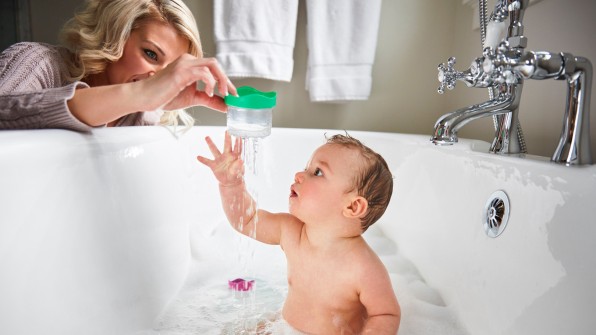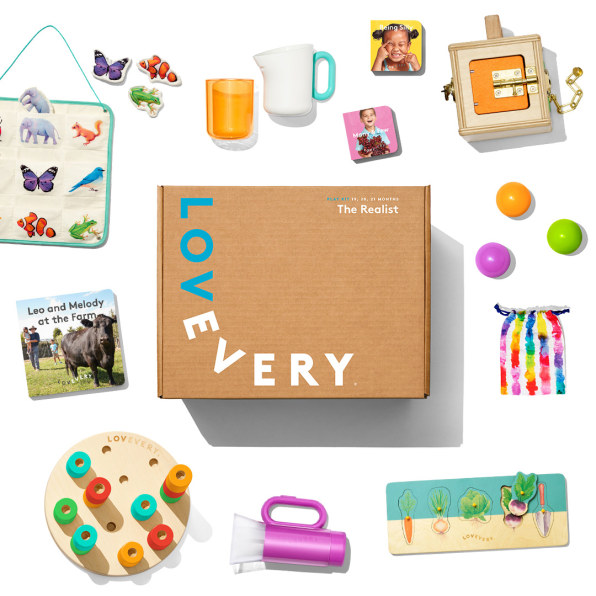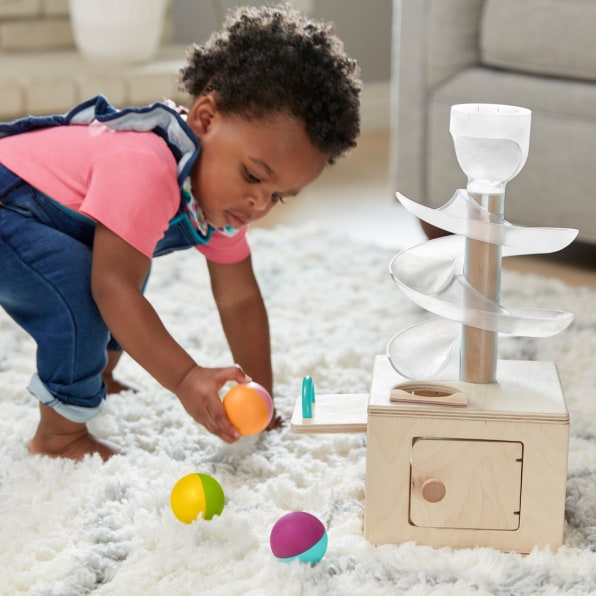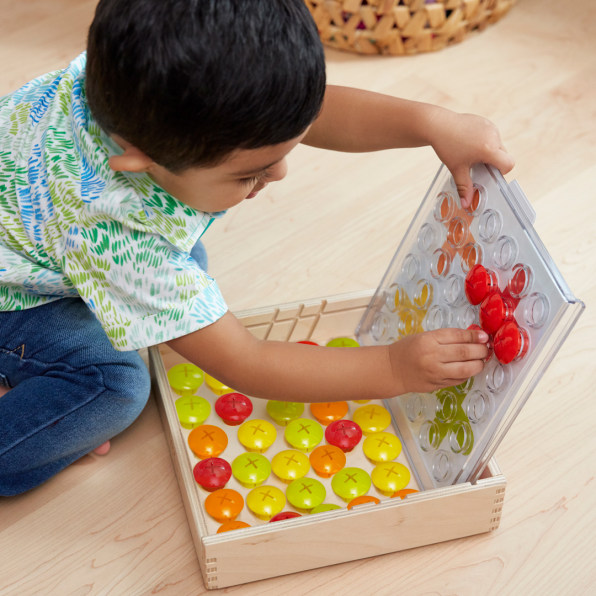Make Child's Drawing Into Toy
My toddler has been happily playing in the bath for more than an hour. I can't bear to take her out because she seems to be having so much fun playing with a set of six clear cups with different configurations of holes at the bottom. As she fills each one with water, the fluid trickles out in different ways. With the large cup, the water pours out in a kind of rainfall effect; in a smaller one, it drips out slowly. She's utterly enraptured, laughing with delight.
This is one of a dozen toys that comes in a box made by the startup Lovevery (pronounced Love Every), which creates toys for each stage of a child's brain development. The company launched with $80 play kits that take babies through their first year of life, two months at a time. In the first box, for instance, you receive a set of cards with black and white high-contrast images that are suited for newborns whose vision is slowly sharpening. In the box for 10-month-olds, there's a blanket specifically designed to play peekaboo, a favorite game for babies who are just learning about object permanence.

Starting this week, Lovevery launches boxes tailored to children's second year of life, with each $120 play kit designed for three months at a time. The boxes also come with a play guide for parents to help them understand what is going on in their child's mind, explains what the toys are designed to do, and offers other helpful tips for bonding with their child. Parents can either purchase the box one at a time from the Lovevery website, or they can sign up for a subscription so the toys arrive on a regular basis, exactly when the child is ready to play with them.
There are other toy subscription boxes on the market, including Little Passports, which introduces children to different countries, and KiwiC0, which has a focus on teaching science skills. But subscription commerce is a tough business. Five years ago, there was a sudden glut of subscription boxes on the market, but as I have reported, dozens of them have failed. In general, the model works best if the subscription approach is about more than just the novelty of receiving a box of surprise products in the mail but actually solves problems for the customer. Menstrual product subscription brands like Cora and Lola have done well in part because women need new supplies of these products every month. Subscriptions to early childhood toys make a lot of sense because babies and toddlers get bored of toys quickly, forcing parents to spend time at toy stores or on Amazon's toy section to keep their kids occupied. And it means parents don't have to spend time researching what's most developmentally appropriate for each stage. The toys just show up in the mail at the right time.

Lovevery was co-founded by Jessica Rolph, who previously launched HappyFamily, which makes children's organic food. A few years ago, she stumbled across a doctorate thesis written by William Staso, a doctor who specializes in baby brain development. She was intrigued by his findings about how the neurological architecture of a baby's brain is formed in their first three years of life. Suddenly she began to feel like many of the toys in her children's nursery were not actually meeting their particular developmental needs. "We know that the first three years of a child's life so important for laying the foundation for their intellectual development throughout their lives," says Rolph. "I think a lot of parents want to help nurture their children's curiosity, but they don't know exactly what they need."
Lovevery's first product was a $140 infant play gym that was sold through Amazon and the brand's website. The product got many positive reviews and also received awards from organizations like Parent's Choice, Red Dot, and The Bump. The success of that product led Rolph to launch these boxes.
Each Lovevery box is designed with the help of 10 child development specialists from a range of pedagogical schools including Montessori and Reggio Emilia. (Dr. Staso is among them.) Rolph and the team prototype dozens of toys that are appropriate for each stage of a child's development, then tests the toys with 25 families. The team goes into their homes to see how the children interact with the products. "Some toys that we were excited about because they were cleverly designed to challenge a child proved to be total duds," Rolph says, describing how the kids simply did not want to play with them. "Other toys that we thought were boring were extremely exciting to the children."
Many infant and toddler toys on the market right now are designed to stimulate and often have electronic features, like flashing lights and sounds. The toys in these kits are noticeably low-tech. They are mostly made from reclaimed wood and organic cotton fabric, although there are some plastic items in the mix. The toys are also made from durable materials, so they can be passed on from one child to the next.

On the surface, they appear very simple. But Jody Malterre, a Montessori specialist who advises Lovevery, says that the simplicity is what actually engages the children. "Children are endlessly curious, but they can be overwhelmed by toys that are just full of too many bells and whistles," she says. "These toys are carefully designed to help children master a particular task, and if they're at the right age for it, they tend to get very absorbed in trying to understand how it works."
Case in point: My daughter spending hours in the bathtub figuring out how the cups work. In this case, the toy was effectively teaching her about gravity and how fluids work. The toy is simple, and she's able to focus on pouring water into them without any distractions. And because the cups are so simple, they can serve many purposes. After the bath, they become bowls for her tea party. Later, she stacks them into a tower. "We create each toy with some goals in mind," says Rolph. "But we also intentionally design them so that the child can also use their imagination to play with them in other ways."

One thing that Rolph learned from Staso's research, and other child development studies, is that children are most attracted to toys that help them acquire real life skills. In one of the new toddler boxes, there is a little glass and a pitcher with a groove on it that makes it easy for a two and a half year old to practice pouring. The booklet encourages parents to let their children practice pouring their own milk or juice. Another toy in that kit is a usable flashlight with buttons perfectly designed for little hands. In the box my daughter received, there was a soft tube covered in buckles for her to practice opening and closing. "Children's brains are wired to help them make their way in the world," says Rolph. "They're always trying to do what adults are doing. These are toys that help them develop some of these skills in a fun way."
While Lovevery toys are certainly well-designed, it will still be a challenge for the brand to compete in a crowded toy market, which is full of big players like Fisher-Price, Leap Frog, and Melissa and Doug. These brands collectively churn out hundreds of new toys every season, at much lower price points. As a digitally native brand at the higher end of the market, Lovevery is likely to appeal to millennials who already buy many products online. But for affluent parents who will spare no expense to give their kids a headstart in school—and life—these boxes will make toy shopping much more convenient.
Make Child's Drawing Into Toy
Source: https://www.fastcompany.com/90343198/these-beautifully-designed-toys-are-good-for-kids-brain-development
Posted by: houckearon1950.blogspot.com

0 Response to "Make Child's Drawing Into Toy"
Post a Comment